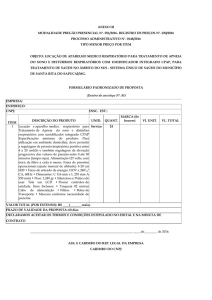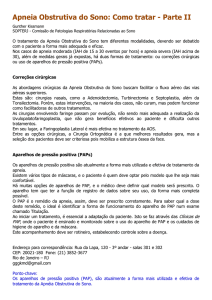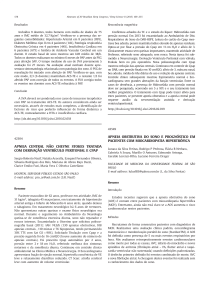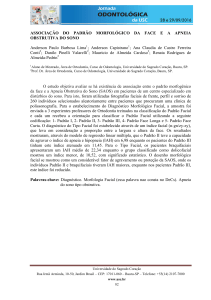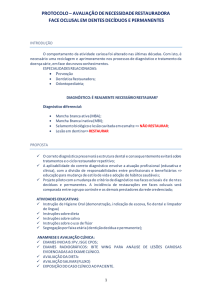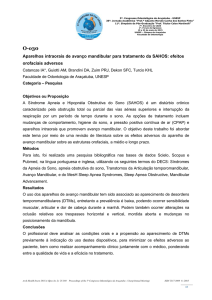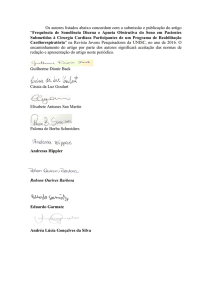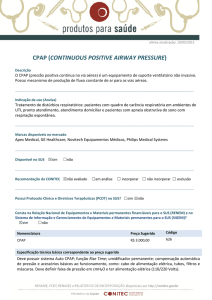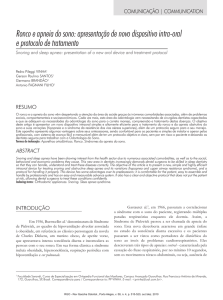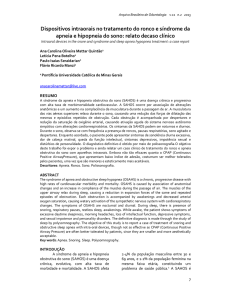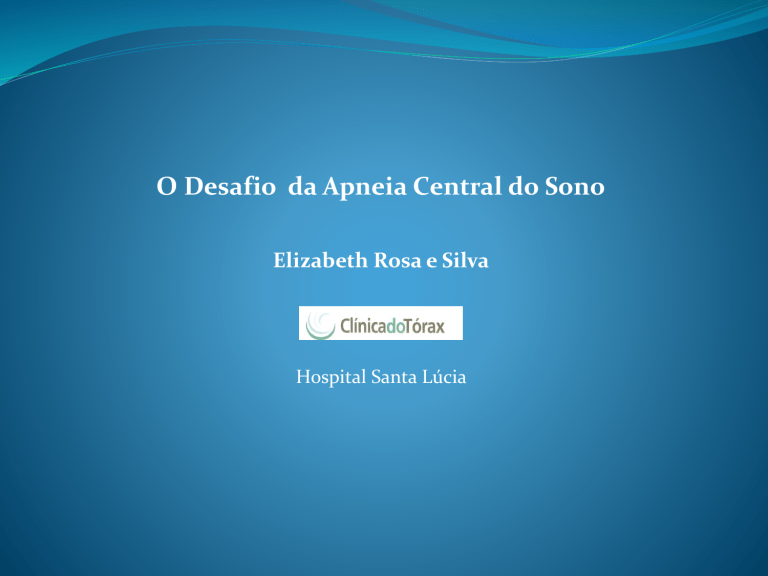
O Desafio da Apneia Central do Sono
Elizabeth Rosa e Silva
Hospital Santa Lúcia
Apneia Central do Sono
Conceito
Fisiopatologia
Respiração de Cheyne Stokes
Casos clínicos
Tratamento
Conclusões
Apneia Central do Sono
Conceito
Fisiopatologia
Respiração de Cheyne Stokes
Casos clínicos
Tratamento
Conclusões
APNEIA CENTRAL
Figure 1. Polysomnographic recordings of central and obstructive hypopneas from patients with heart failure with
use of respiratory inductance plethysmography (RIP). The upper panel shows a central hypopnea during stage 2
sleep in a patient who has Cheyne-Stokes respiration with central sleep apnea. Note in-phase gradual waxing and
waning of tidal volume during hyperpnea, and only minimal O2 desaturation during hypopnea. Arousal occurs
several breaths after termination of the hypopnea. The lower panel shows an obstructive hypopnea in a patient with
obstructive sleep apnea. Note that in contrast to central hypopnea, rib cage and abdominal motion are out-of-phase
and O2 desaturation is greater during hypopnea, the rise in ventilation following its termination is more abrupt and
hyperpneas are shorter. In addition, arousals occur earlier at hypopnea termination. EEG = electroencephalogram;
EKG = electrocardiogram; EMGsm = submental electromyogram; EMGat = anterior tibial EMG; EOG =
electrooculogram. Arrows (↓) indicate arousals.
Proc Am Thorac Soc,
Published in: Dai Yumino; T. Douglas Bradley; Proc Am Thorac Soc 2008, 5, 226-236.
© 2008 The American Thoracic Society
Apneia Central do Sono
Conceito
Fisiopatologia
Respiração de Cheyne Stokes
Casos clínicos
Tratamento
Conclusões
Figure 2. Polysomnographic recordings demonstrating differences in periodic breathing patterns between a patient with and without heart failure (HF).
The upper panel shows a recording from a patient with idiopathic central sleep apnea (ICSA) during stage 2 sleep. Apnea length (AB) is 18 seconds,
hyperpnea length (BD) is 7 seconds, and cycle length (AD) is 25 seconds. C represents the nadir of SaO2 (arterial oxygen saturation), detected by an
oximeter placed on the ear in close proximity to the carotid body chemoreceptors. From the end of apnea (B) to the nadir in SaO2 (C) is the lung-to-ear
circulation time (BC), which is 8 seconds and approximates lung-to-carotid body circulation time. The lower panel is a recording from a patient with HF
and Cheyne-Stokes respiration with central sleep apnea (CSR-CSA) during stage 2 sleep. Compared with the patient with ICSA, lung-to-ear circulation
time (BC = 26 s), hyperpnea (BD = 46 s), and cycle lengths (AD = 65 s) are substantially longer. However, apnea length (AB = 21 s) is similar. Abbreviations
are the same as for Figure 1. Adapted by permission from Reference 28.
Proc Am Thorac Soc,
Published in: Dai Yumino; T. Douglas Bradley; Proc Am Thorac Soc 2008, 5, 226-236.
© 2008 The American Thoracic Society
Fisiopatologia AC-CS
PAO2 = PiO2-PaCO2
PaO2
Figure 3. Pathophysiologic scheme of CSR-CSA in heart failure. BP = blood pressure; HR = heart rate; SNA = sympathetic nervous system activity.
Modified by permission from Reference 93.
Proc Am Thorac Soc,
Published in: Dai Yumino; T. Douglas Bradley; Proc Am Thorac Soc 2008, 5, 226-236.
© 2008 The American Thoracic Society
Apneia Central do Sono
Cheyne Stokes
Apneia Central – Cheyne-Stokes
Comum em IVE (Instabilidade sistema respiratório)
Congestão Pulmonar
Sensibilidade - receptor periférico e central
Fluxo sanguíneo cerebral
Outros fatores?
Dai Yumino and T. Douglas Bradley "Central Sleep Apnea and Cheyne-Stokes Respiration",Proceedings of the American Thoracic Society, Vol. 5, No. 2 (2008), pp. 226-236.
Apneia Central do Sono
Conceito
Fisiopatologia
Respiração de Cheyne Stokes
Casos clínicos
Tratamento
Conclusões
JAR, 82 anos
DPOC, Hipertensão, Aneurisma de Aorta
PSG
DATA
IAH
AC
AO
REM
...
DIAG
20/06/2012
36/h
191
13
...
...
BIPAP
13/07/2012
18/h
AC-CS
CPAP
16/10/2012
32/h
101
4
1%
SV
19/03/2013
0/h
0
0
27%
JAR, 82 anos
DPOC, Hipertensão, Aneurisma de Aorta
IAH 32/h
CPAP
16/10/12
JAR, 82 anos
DPOC, Hipertensão, Aneurisma de Aorta
CPAP
16/10/12
IAH 32/h
JAR, 82 anos
DPOC, Hipertensão, Aneurisma de Aorta
CPAP
16/10/12
IAH 32/h
JAR, 82 anos
DPOC, Hipertensão, Aneurisma de Aorta
CPAP - IAH 32/h
16/10/12
JAR, 82 anos
DPOC, Hipertensão, Aneurisma de Aorta
SV - IAH 0/h
19/03/13
JAR , 82 anos
DPOC, Hipertensão, Aneurisma de Aorta
SV - IAH 0/h
19/03/13
IBF, 60 anos
Arritmia cardíaca, Síndrome de resistência à insulina,
Hipotiroidismo
PSG
DATA
IAH
AC
AO-AM HIPO
REM
SpO2
DIAG
08/04/2015
48/h
178
146
13%
16%
CPAP
10/06/2015
3/h
7
17
30%
1%
IBF, 60 anos
Arritmia cardíaca, Síndrome de resistência à insulina,
Hipotiroidismo
DIAG
08/04/15
IBF, 60 anos
Arritmia cardíaca, Síndrome de resistência à insulina,
Hipotiroidismo
DIAG
08/04/15
IBF, 60 anos
Arritmia cardíaca, Síndrome de resistência à insulina,
Hipotiroidismo
08/04/15
IBF, 60 anos
Arritmia cardíaca, Síndrome de resistência à insulina,
Hipotiroidismo
08/04/15
IBF, 60 anos
Arritmia cardíaca, Síndrome de resistência à insulina,
Hipotiroidismo
PSG
DATA
IAH
AC
AO-AM HIPO
REM
SpO2
DIAG
08/04/2015
48/h
178
146
13%
16%
CPAP
10/06/2015
3/h
7
17
30%
1%
IBF, 60 anos
Arritmia cardíaca, Síndrome de resistência à insulina,
Hipotiroidismo
CPAP
10/06/15
RBP, 59 anos (2014)
Arritmia cardíaca, Diabete, Dislipidemia
PSG
DATA
IAH
AC
AO-AM
HIPO
REM
SpO2
DIAG
29/06/2007
29/h
...
...
...
18%
CPAP / BIPAP
17/04/2014
56/h
290
9
11%
1%
SV
03/07/2014
7/h
29
3
15%
0%
RBP, 59 anos (2014)
Arritmia cardíaca, Diabete, Dislipidemia
CPAP / BIPAP – IAH 56/h
17/04/14
RBP, 59 anos (2014)
Arritmia cardíaca, Diabete, Dislipidemia
SV –IAH 7/h
03/07/14
Apneia Central do Sono
Conceito
Fisiopatologia
Respiração de Cheyne Stokes
Casos clínicos
Tratamento
Conclusões
The Canadian Continuous Positive Airway Pressure for Patients with Central Sleep Apnea and Heart Failure (CANPAP)
204 pacientes
n engl j med 353;19 www.nejm.org november 10, 2005
The Canadian Continuous Positive Airway Pressure for Patients with Central Sleep Apnea and Heart Failure (CANPAP)
The Canadian Continuous Positive Airway Pressure for Patients with Central Sleep Apnea and Heart Failure (CANPAP)
Tratamento
CPAP
Reduz o IAH em AC
Aumenta a fração de ejeção ICC c/ AC-CS
Reduz a mortalidade
Melhora a oxigenação noturna
Diminui os níveis de norepinefrina
Teste de caminhada
Tratamento
Espaço morto (VD)
400ml a 800ml VD
Aumenta a reinalação de CO2
apneia
Acima do limiar de
PaCO2 de 1,5 a 2,0 mm Hg –
Estabilizar o padrão respiratório
Precaução : VD e CO2
Piora da apneia obstrutiva
Tratamento
SV (Servo Ventilator)
Superior ao CPAP
Melhora a arquitetura do sono
Melhora a sonolência diurna
Como CPAP
e corrige o IAH
Aumenta a SpO2
Reduz a frequência cardíaca
Melhora os níveis de BNP
Tratamento
OXIGÊNIO
Melhora FE
Atenua a reposta hiperventilatória
MARCAPASSO
IAH em 60% pacientes com bradicardia sinusal
sintomático
Apneia Central do Sono
Conceito
Fisiopatologia
Respiração de Cheyne Stokes
Casos clínicos
Tratamento
Conclusões
CONCLUSÕES
Apneia Central do Sono
É causada por instabilidade do controle da respiração
por tendência à hiperventilação.
É frequente em pacientes com insuficiência cardíaca e
quando associada à CS, sugere pior prognóstico.
Os pacientes podem se beneficiar do tratamento com
CPAP, SV, Aumento do VD, O2.

